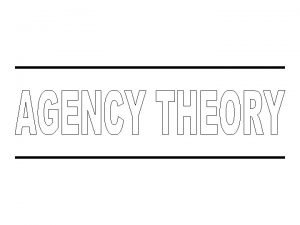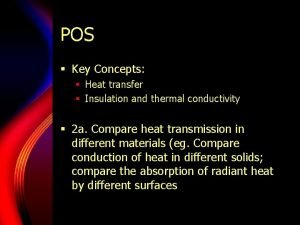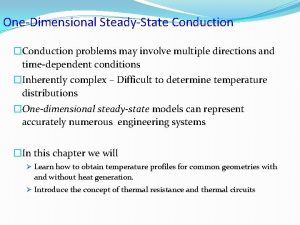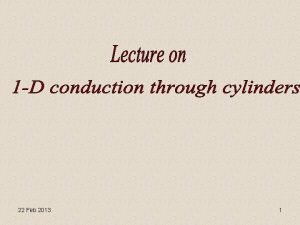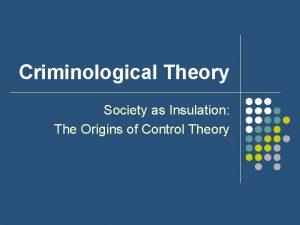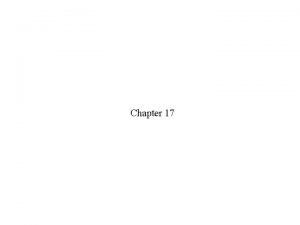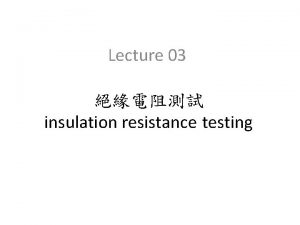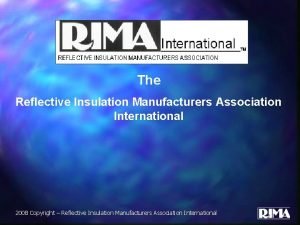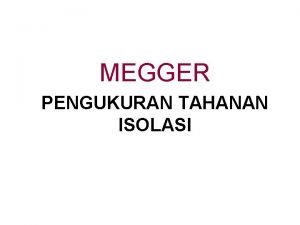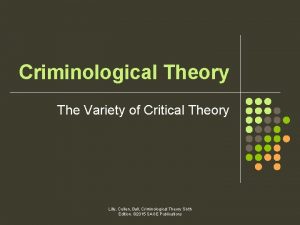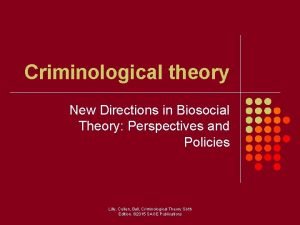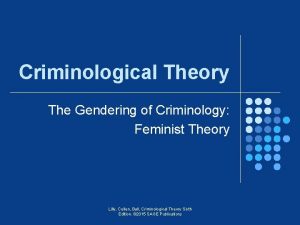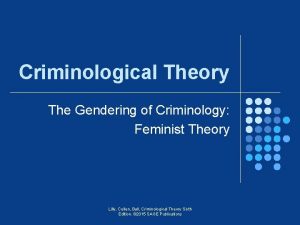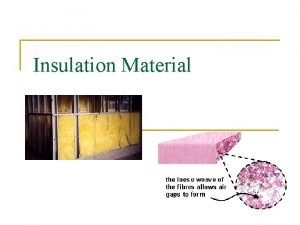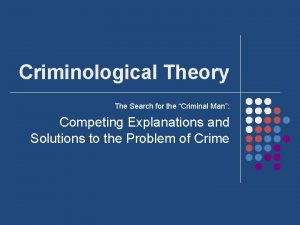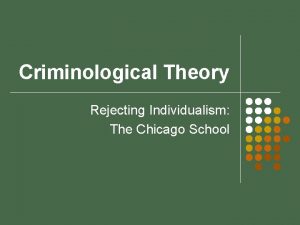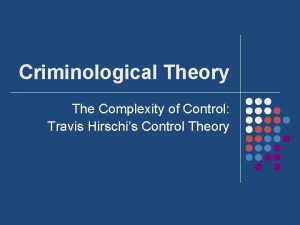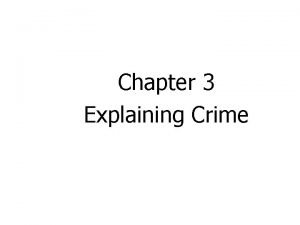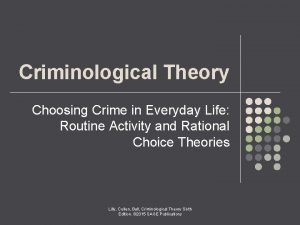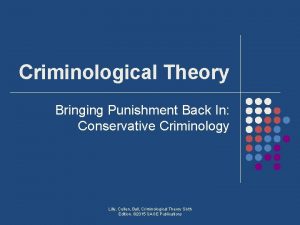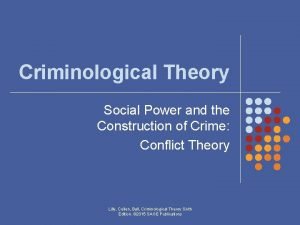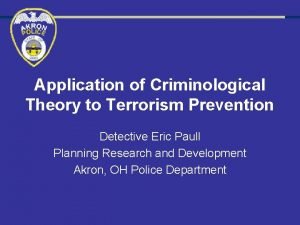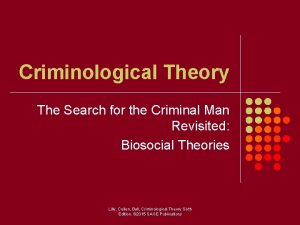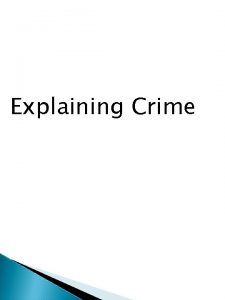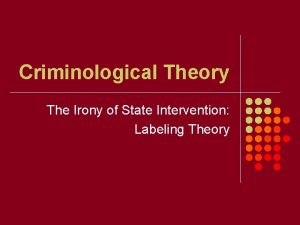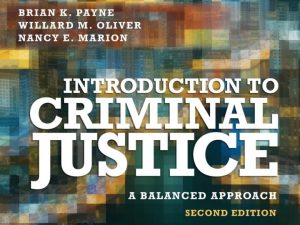Criminological Theory Society as Insulation The Origins of




































- Slides: 36

Criminological Theory Society as Insulation: The Origins of Control Theory

Introduction: Control Theory l Control theory takes the position that because conformity cannot be taken for granted, nonconformity, such as crime and delinquency, is to be expected when social controls are less than completely effective l The question asked by control theorist: Why do people conform?

Introduction: Control Theory l The main theoretical premise: l Because crime is fun, enjoyable, and rewarding, when controls are absent, crime is possible and often does occur l When controls are present, crime does not occur

Forerunners of Control Theory: Durkheim’s Anomie Theory l The origins of contemporary control theories of crime and delinquency are to be found in part in the work of Durkheim’s anomie theory l Anomie: The destruction of the fundamental bonds uniting individuals in a collective social order so that each person is forced to go it alone l Technology and the rise of capitalism has lead to an eroded sense of community

Forerunners of Control Theory: Durkheim’s Anomie Theory Social solidarity was maintained by two sets of functions: l Integration: A state of cohesion amounting to a common faith sustained by collective beliefs and practices leading to strong social bonds and the subordination of self to a common cause 1. l Collective activity gives purpose and meaning Regulation: The sum of social forces of constraint that bound individuals to norms 2. l Constraining regulative functions become more important in an urban society with a complex division of labor

Forerunners of Control Theory: Durkheim’s Anomie Theory The nature of “man” argues that any person is a blend of two aspects: • • 1. The social self or the aspect of self that looks to society and is a product of socialization and cultivation of human potentials (the “civilized” member of a community) 2. The egotistic self or the primal self that is incomplete without society and that is full of impulses knowing no natural limits Social solidarity based on integration and regulation allowed the more primal self to become fully humanized in a life shared with others on moral common ground

Forerunners of Control Theory: The Influence of the Chicago School l Control theories were also influenced by the social disorganization perspective l Two Chicago schools themes remained central: 1. The interpretations of human nature 2. The nature of community

Forerunners of Control Theory: The Influence of the Chicago School l Conceptions of Human Nature l Charles H. Cooley – Chicago school of social psychology l Human offspring are dependent on other humans l Family is the main primary group where interaction is of an intimate face-to-face character leading to a wefeeling or sense of belonging and identification with the group

Forerunners of Control Theory: The Influence of the Chicago School l Looking-Glass Self l The child develops a concept of who he or she really is by imagining how he or she appears to others and how others interpret and evaluate what they perceive and then by forming a sense of self based on that process

Forerunners of Control Theory: The Influence of the Chicago School l George Herbert Mead (1934) l Divided the individual into the “I” and “Me” l “I” represents a process of fundamental awareness that becomes focused in different ways, leading to the development of the social self or “me” l The focusing was said to occur through a process of taking the role of the other, which is how socialization occurred l Unsuccessful socialization might lead to personal disorganization – a self lacking in integration and consistency

The Study of Community l The decline in the moral integration of the basic primary groups themselves was important to the early control theorists l Suggested not only social disorganization, but also personal disorganization resulting from fundamental problems in the formation of the personal self

Early Control Theorists: Albert J. Reiss l Attempted to predict juvenile delinquency by explaining personal and social controls l Personal control: The ability of the individual to refrain from meeting needs in ways which conflict with the norms and rules of the community l Social control: The ability of social groups or institutions to make norms or rules effective

Early Control Theorists: Albert J. Reiss l Delinquency results when there is a relative absence of internalized norms, a breakdown in previously established controls, and an absence of or conflict in social rules l Conformity results when the individual has an acceptance of the rules or has a submission to them

Early Control Theorists: Albert J. Reiss l Considered from the “perspective of the person, ” social control was held to lie in the acceptance of or submission to the authority of the institution and the reinforcement of existing personal controls by institutional controls

Early Control Theorists: Albert J. Reiss l Considered from “the standpoint of the group, ” control was said to lie in the nature and strength of the norms of the institutions and the effectiveness of the institutional rules in obtaining behavior and conformity with the norms

Early Control Theorists: Albert J. Reiss l The delinquent peer group is viewed as a functional consequence of the failure of personal and social controls l Trying pin down those factors that had to occur before any causes could be expected to produce delinquent effects l Chief concern as a predictor was the failure to submit to social controls

Early Control Theorists: Albert J. Reiss l Delinquency and delinquent recidivism may be viewed as a consequence of the failure of primary groups to provide the child with appropriate nondelinquent roles and to exercise social control over the child so these roles are accepted or submitted to in accordance with needs l Key groups are the family, neighborhood, and school

Early Control Theorists: F. Ivan Nye l Sought to explain why delinquent and criminal behavior is not more common l Locate social control factors that inhibited nonconformity and made crime and delinquency a possibility l Family most important social control over adolescents

Early Control Theorists: F. Ivan Nye l l The family could generate: 1. Direct control: External forces 2. Internalized control: Internal forces or conscience 3. Indirect control: Extent of affection and identification with authority figures 4. Control through alternative means of need satisfaction: “Delivery of goods” in a legitimate way These types of control are mutually reinforcing

Containment Theory: Water C. Reckless l Search for self-factors that would explain why some individuals succumbed to social pressures leading to crime and delinquency, whereas others remained relatively law abiding in the same circumstances l l Resiliency: People who, despite facing many criminogenic risk factors, resist crime Central problem lay in explaining differential responses

Containment Theory: Water C. Reckless l The Social Psychology of the Self l The social transformation from life in fairly simple societies to complex environments placed a different set of pressures on the individual and the social order l “New pitch”: Society that emphasizes freedom and allows people to not be connected to one another l “Individualization of the self” : People are separate and distinct from the mass of others

Containment Theory: Water C. Reckless l Pushes and Pulls (Table 5. 1) l l A variety of factors might “push” a person towards crime and delinquency, and other factors might “pull” one toward misbehavior Despite the various criminogenic pushes and pulls, whatever they may be, conformity remains the general state of affairs

Containment Theory: Water C. Reckless l To commit crime or delinquency , the individual must break through a combination of outer containment and inner containment that together tend to insulate the person from both the pushes and pulls l A risk theory: Each weakening containment increased the odds of nonconformity

Containment Theory: Water C. Reckless l Factors in Outer Containment (Table 5. 1) l Concentrating on the external containment model for the urban, modern society, he stressed: l Reasonable limits l Meaningful roles and activities l Several complimentary variables

Containment Theory: Water C. Reckless l Factors in Inner Containment (Table 5. 1) l l Tends to control the individual to some extent no matter how the external environment changed The key factors of inner containment include: l l Self-concept: Good boys had insulated self-concepts Goal orientation: Sense of direction in life toward legitimate goals Frustration tolerance: Ability to cope with frustration Norm retention: Acceptance of norms, laws, values, and customs; acceptance of legitimate means

Early Control Theorists: Summary l The increase in crime was a product of the modern world l Regarded the moral order as more fundamental than the economic order and concerned itself with what it took to be the problem of the individual in a complex society l Boundless desires, little capacity to tolerate denial, and no sense of direction or commitment to traditional rules

Neutralization and Drift Theory: Sykes and Matza l Sought to explain that If the social pressures causing delinquency were so powerful, why was it that even the worst of the delinquents seemed to be fairly conventional people, actually conforming in so many other ways? l Also, why did most not continue law-violating behavior beyond a certain age

Neutralization and Drift Theory: Sykes and Matza l Techniques of Neutralization l Argued that delinquents retained a commitment to conventional society and its standards of behavior; they knew right from wrong l Delinquency would be possible if youths could escape the control that conventional society had over them

Neutralization and Drift Theory: Sykes and Matza l Conventional social norms consisted of the learning of excuses or techniques of neutralization by which those norms could be temporarily suspended and their controlling effects neutralized l Free to deviate without rejecting the norms

Neutralization and Drift Theory: Sykes and Matza Five Techniques of Neutralization (Table 5. 2) l 1. Denial of responsibility 2. Denial of injury 3. Denial of the victim 4. Condemnation of the condemners 5. Appeal to higher loyalties

Neutralization and Drift Theory: Sykes and Matza l Delinquents were no more committed to their delinquency than to conventional enterprises l Delinquency was a matter of “drift” facilitated by the existence of “subterranean convergence” between their own techniques of neutralization and certain ideologies of authorities who represented the official moral order l Authorities often excuse violations § Blame parents, cite provocation of victim, accept selfdefense explanations, etc.

Neutralization and Drift Theory: Sykes and Matza l Because delinquency may involve unfamiliar and dangerous behaviors, something more than the loss of control/neutralization is necessary to explain it l Preparation: A process by which the person discovered that a given infraction could be pulled off by someone, that the individual could do it himself, and that the fear of apprehension could be managed

Neutralization and Drift Theory: Sykes and Matza l Desperation: The central force is a profound sense of fatalism, a feeling that the self was overwhelmed, with a consequent need to violate rules of the system to reassert individuality l The combination of preparation and desperation creates the will to offend

Control Theory in Context l Context of the 1950 s l This time was marked by a time of relative social conformity, so much so, the U. S. was seen as a nation of sheeps l l Thus, delinquency seen as a result of departures from the conventional order The onslaught of the 1960 s was to make control theory much more popular

Control Theory in Context l The Context of the 1960 s l The 1960 s had massive social change which seemed to many to signal the complete collapse of personal and social control l The Civil Rights movement l Militant feminism l The Vietnam War protests l Hippies l Psychedelic drugs

Control Theory in Context l The Context of the 1960 s l The social turmoil seemed to many to signal the complte collapse of personal and social control l Nation was seen as being torn apart and social consensus as being eroded completely l The decade was characterized by the loss of self-control l The times were ripe for acceptance of a perspective linking crime to the breakdown of control if it could be formulated in appropriate theoretical terms
 Criminal psychology definition
Criminal psychology definition Agency theory economics
Agency theory economics Gertler econ
Gertler econ Insulation resistance of transformer
Insulation resistance of transformer Critical insulation thickness
Critical insulation thickness Corrosion under insulation primer
Corrosion under insulation primer Energy transfer
Energy transfer Steady state heat conduction
Steady state heat conduction Insulation thickness calculator
Insulation thickness calculator Critical insulation thickness
Critical insulation thickness Thermal conduction resistance
Thermal conduction resistance Global specialised systems
Global specialised systems Wrbs
Wrbs What is critical thickness of insulation
What is critical thickness of insulation Chapter 17 thermal and sound insulation
Chapter 17 thermal and sound insulation Applications of insulating materials
Applications of insulating materials What is critical radius of insulation
What is critical radius of insulation Switching overvoltages in ehv and uhv systems
Switching overvoltages in ehv and uhv systems Containment theory criminology
Containment theory criminology A gas cylinder and piston are covered with heavy insulation
A gas cylinder and piston are covered with heavy insulation Architectural material symbols
Architectural material symbols Natural science grade 7 term 3
Natural science grade 7 term 3 Knauf insulation d.o.o.
Knauf insulation d.o.o. Insulation coordination winnipeg
Insulation coordination winnipeg Pre finished insulation board
Pre finished insulation board Thermal insulation home
Thermal insulation home Insulation resistance
Insulation resistance Reflective insulation manufacturers association
Reflective insulation manufacturers association Sempatap review
Sempatap review Fungsi megger
Fungsi megger Most common liquid insulation is
Most common liquid insulation is Insulation coordination example
Insulation coordination example Eagle insulation
Eagle insulation Wrapped multi layer insulation
Wrapped multi layer insulation Hình ảnh bộ gõ cơ thể búng tay
Hình ảnh bộ gõ cơ thể búng tay Bổ thể
Bổ thể

